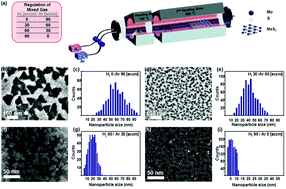Size-tunable synthesis of monolayer MoS2 nanoparticles and their applications in non-volatile memory devices†
Abstract
We report the CVD synthesis of a monolayer of MoS2 nanoparticles such that the nanoparticle size was controlled over the range 5–100 nm and the chemical potential of sulfur was modified, both by controlling the hydrogen flow rate during the CVD process. As the hydrogen flow rate was increased, the reaction process of sulfur changed from a “sulfiding” process to a “sulfo-reductive” process, resulting in the growth of smaller MoS2 nanoparticles on the substrates. The size control, crystalline quality, chemical configuration, and distribution uniformity of the CVD-grown monolayer MoS2 nanoparticles were confirmed. The growth of the MoS2 nanoparticles at different edge states was studied using density functional theory calculations to clarify the size-tunable mechanism. A non-volatile memory device fabricated using the CVD-grown size-controlled 5 nm monolayer MoS2 nanoparticles as a floating gate showed a good memory window of 5–8 V and an excellent retention period of a decade.


 Please wait while we load your content...
Please wait while we load your content...